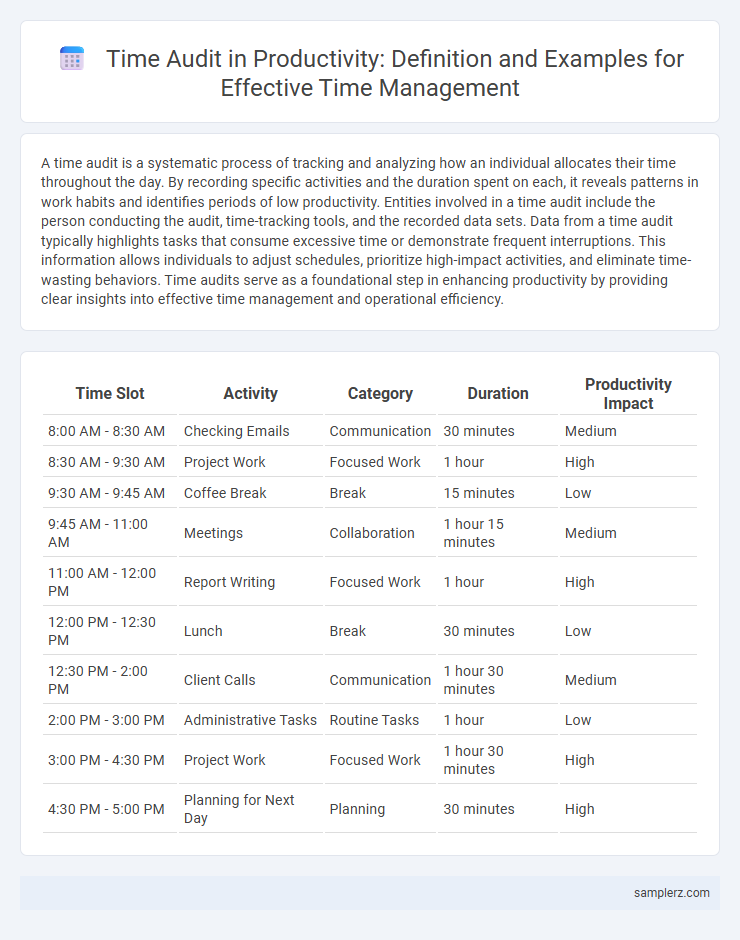A time audit is a systematic process of tracking and analyzing how an individual allocates their time throughout the day. By recording specific activities and the duration spent on each, it reveals patterns in work habits and identifies periods of low productivity. Entities involved in a time audit include the person conducting the audit, time-tracking tools, and the recorded data sets. Data from a time audit typically highlights tasks that consume excessive time or demonstrate frequent interruptions. This information allows individuals to adjust schedules, prioritize high-impact activities, and eliminate time-wasting behaviors. Time audits serve as a foundational step in enhancing productivity by providing clear insights into effective time management and operational efficiency.
Table of Comparison
| Time Slot | Activity | Category | Duration | Productivity Impact |
|---|---|---|---|---|
| 8:00 AM - 8:30 AM | Checking Emails | Communication | 30 minutes | Medium |
| 8:30 AM - 9:30 AM | Project Work | Focused Work | 1 hour | High |
| 9:30 AM - 9:45 AM | Coffee Break | Break | 15 minutes | Low |
| 9:45 AM - 11:00 AM | Meetings | Collaboration | 1 hour 15 minutes | Medium |
| 11:00 AM - 12:00 PM | Report Writing | Focused Work | 1 hour | High |
| 12:00 PM - 12:30 PM | Lunch | Break | 30 minutes | Low |
| 12:30 PM - 2:00 PM | Client Calls | Communication | 1 hour 30 minutes | Medium |
| 2:00 PM - 3:00 PM | Administrative Tasks | Routine Tasks | 1 hour | Low |
| 3:00 PM - 4:30 PM | Project Work | Focused Work | 1 hour 30 minutes | High |
| 4:30 PM - 5:00 PM | Planning for Next Day | Planning | 30 minutes | High |
Understanding Time Audit: A Key Productivity Tool
Time audit involves tracking how every minute of the workday is spent to identify productivity patterns and time-wasting activities. By analyzing detailed records of tasks, interruptions, and breaks, individuals can pinpoint inefficiencies and optimize their schedules for maximum output. This focused self-assessment enhances time management and drives sustained productivity improvements.
Why Conduct a Time Audit for Productivity Gains
Conducting a time audit reveals detailed insights into how each hour is spent, identifying time-wasting activities that hinder productivity. This process helps pinpoint inefficiencies and prioritize high-impact tasks, ultimately enhancing time management skills. Businesses and individuals can leverage time audits to align daily actions with strategic goals, driving measurable productivity gains.
Step-by-Step Guide to Performing a Time Audit
Performing a time audit involves tracking every activity throughout the day to identify unproductive habits and optimize schedules effectively. Start by recording tasks in 15- to 30-minute intervals for at least one week using tools like time-tracking apps or spreadsheets. Analyze the collected data to categorize time spent on work, breaks, and distractions, then adjust priorities and eliminate non-essential tasks to boost overall productivity.
Real-Life Examples of Time Audits in the Workplace
Conducting a time audit in the workplace involves tracking daily activities to identify time-wasting habits and optimize productivity. For instance, a marketing team analyzed their meeting durations and reduced unnecessary gatherings by 30%, reallocating saved time to content creation and campaign analysis. A software development firm used time audits to uncover frequent interruptions, implementing focused work blocks that increased coding efficiency by 20%.
How Time Audits Reveal Productivity Killers
Time audits systematically track how every minute is spent during work hours, exposing hidden productivity killers such as frequent task-switching and unplanned meetings. Analyzing detailed time logs helps identify patterns of distraction and inefficient time allocation, enabling targeted improvements. Organizations leveraging time audits report up to a 25% increase in focused work time by addressing uncovered productivity drains.
Time Audit Templates: Effective Formats and Samples
Time audit templates provide structured formats to track and analyze daily activities, helping identify time-wasting tasks and optimize productivity. Effective samples include hourly logs, categorized activity charts, and priority matrices that highlight how time is allocated across projects and breaks. Utilizing these templates enables professionals to make data-driven adjustments, improving focus and achieving better work-life balance.
Analyzing Your Daily Schedule: A Time Audit Example
Conducting a time audit involves meticulously tracking how each hour of your day is spent, identifying periods of high productivity and time wastage. For example, logging activities from 9 AM to 5 PM can reveal patterns such as excessive time on emails or unplanned meetings that disrupt focus. Analyzing these insights allows restructuring your daily schedule to prioritize deep work, enhance time management, and boost overall productivity.
Transforming Time Audit Insights into Actionable Changes
Time audits reveal precise patterns of time allocation, identifying both productivity bottlenecks and periods of high efficiency. Analyzing this data allows for targeted adjustments such as rescheduling tasks to peak focus times or eliminating non-essential activities to optimize workflow. Implementing these actionable changes drives sustained productivity improvements by aligning daily routines with actual performance metrics.
Common Time Audit Findings and Productivity Solutions
Time audits often reveal frequent distractions, unstructured work blocks, and excessive multitasking as major productivity drains. Common findings include prolonged email checking, unplanned meetings, and inconsistent break schedules, leading to reduced focus and efficiency. Implementing scheduled task batching, strict email time windows, and regular short breaks can significantly enhance productivity and time management.
Success Stories: Productivity Improvements After Time Audits
Time audits often reveal hidden patterns of wasted hours, enabling professionals to reallocate efforts towards high-impact tasks and increase overall productivity by up to 30%. For instance, a marketing firm documented a 25% boost in campaign completion rates after identifying and eliminating inefficient meeting times through a detailed time-audit process. Companies leveraging time audits report significant gains in employee focus, task prioritization, and meeting deadlines, driving measurable success in project outcomes.

example of Time audit in productivity Infographic
 samplerz.com
samplerz.com